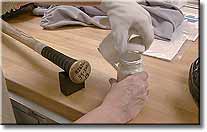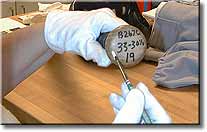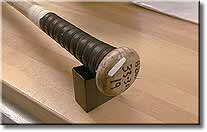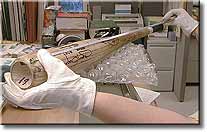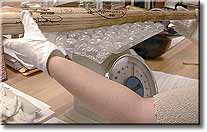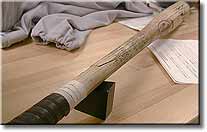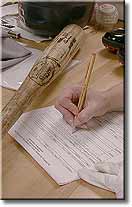 |
||||||||
 |
 |
Accessioning Tony Gwynn's Baseball Bat |
 |
 |
||||
Monday, August 16, 1999 — The first
Gwynn artifact to be accessioned is the bat that Tony used to record his milestone hit.
The Hall of Fame has hundreds of baseball bats of historic significance, including:
Included among the Hall of Fame's collection of bats are those from the 3,000th career hit of all-time baseball greats such as Willie Mays, Hank Aaron, Roberto Clemente, and Carl Yastrzemski. Now the Collections staff prepares to add Tony Gwynn's bat to this prestigious collection.
The first step in accessioning Gwynn's bat is to label the artifact with a unique accession number. Rather than affixing the accession number directly on the bat, the number will be written on a protective coating of white acrylic paint. The acrylic paint is generally applied to the knob of the bat. Note that there is already some writing on the knob of the bat: the bat's number, its weight and length, and the player's uniform number (Gwynn wears #19). These markings are used by ballplayers and clubs to help quickly and easily identify a player's bat. Special care is taken so as not to obscure these original markings, as they are considered an integral part of the artifact. After the acrylic paint has dried, the bat's accession number is written on the white background using black printer's ink. This ink is long-lasting and archivally safe. An artifact's accession number comes in three parts. The first part is a letter designating whether the item has been accessioned through the museum (B) or the library (BL). The number following this letter represents the count of artifacts accessioned during the given calendar year. The final number (following the period) represents the year number itself. In this case, since Tony Gwynn's bat was the 320th item accessioned through the museum in 1999, it is given the accession number B320.99. Next, the length and weight of the bat are determined. Surprisingly, these values often differ from the figures noted on the bat by the manufacturer. In the case of Tony Gwynn's bat, it is found that its actual length is 32½ inches (not 33 inches) and its actual weight is 32 ounces (not 30½ ounces). The bat is also examined for other notable features. For example, it is quickly apparent that Gwynn's bat is cracked above the bat handle. All of this descriptive information along with other relevant data is recorded on the bat's accession form. Museum Bound | Online
Exhibits |
||||||||
 |
 |
 |
 |
|||||
